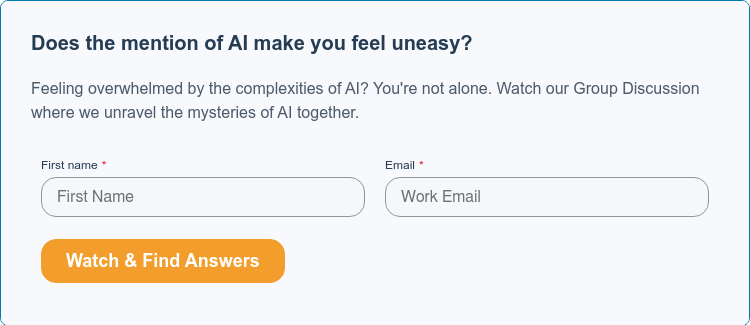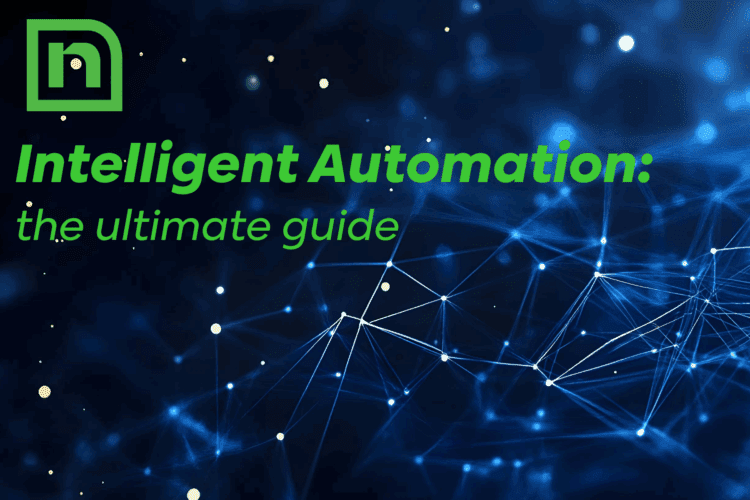When you hear that artificial intelligence (AI) could add between $2.6 and $4.4 trillion in value annually and that 94% of executives believe that artificial intelligence will transform their industries in the next five years, it’s hard not to take notice.
These findings from McKinsey and Deloitte, respectively, are just a couple of the many promising reviews and urgent statistics that we’ve all been bombarded with over the past couple of years surrounding this new technology. But we’ve also been warned that at least 74% of companies that have implemented artificial intelligence in their business functions in some form haven’t captured sufficient value from it. Whether it’s finding new ways to improve your processes with AI, implementing generative AI, or countless other methods, organizations are flocking to it.
Statistics that staggering really give you pause and prompt the question, “So what has stopped companies from getting the most out of their AI tools?”
This blog will answer that question, exploring 10 of the most common challenges to successful AI adoption and how to avoid them.
10 Common AI Adoption Challenges That Threaten AI Success (And How to Solve Them)
1. Lack of a Strategic Vision for AI Opportunities
The Problem: Artificial intelligence is only as effective as the strategy behind it, and this factor alone has tripped many organizations up. With all the hype surrounding the technology, it can be easy to jump on the wagon without doing sufficient research on how to best infuse it into one’s organization.
The Fix: To avoid letting your AI initiative become disjointed and fail to deliver expected results, you need to establish a strategic vision for embracing AI opportunities. In practice, that means conducting a thorough analysis of your business processes to identify areas where AI can have the most significant impact. To determine these areas and their best use cases, engage a cross-functional team to map out a detailed AI roadmap that includes specific goals, timelines, and key performance indicators (KPIs) to track progress.
For best results, this process discovery team shouldn’t just include representatives from across your organization to add a variety of perspectives into your planning, but process mining as well. Process mining gives you the objective truth behind your processes so you can avoid manually combing through your processes and letting human bias or error get involved. It analyzes your software’s digital footprint, allowing it to understand your processes from start to finish as they truly function, not how they’re supposed to function or how your employees might think they function.
And that AI roadmap we discussed earlier? With process mining on your team, it can create that detailed map for you, complete with AI opportunity suggestions prioritized by which use cases will add the most value. As you continue on your AI journey, it’s worth regularly reviewing and adjusting your roadmap to reflect your changing business needs and technological advancements.

2. Fading Leadership Buy-In
The Problem: A lack of support from the top can hinder AI initiatives. Your leaders may be excited about AI’s potential at the beginning of your journey, but the allure can fade when new enticing initiatives are brought to them.
The Fix: First, get an executive sponsor on your team. They will oversee the implementation, rollout, and impact measurement of a digital initiative. AI’s strategic implementation will become the center of their world, and they will remain focused on your initiative throughout. Then, be sure to regularly update the rest of your leadership team with the progress and successes of your initiatives. Highlight how these efforts actively contribute to the business’s strategic goals to keep
3. Data Availability and Quality
The Problem: AI models rely on high-quality data to function effectively. Still, many organizations struggle with poor data quality, from inaccuracies to full-out inaccessible data, which can severely undermine AI models, no matter how advanced they may be.
The Fix: A vital first step is establishing a comprehensive data governance strategy. Doing so will help you maintain the integrity of your data and their processes over time. But you’ll also need to invest in data management technologies that ensure data is clean, well-organized, and readily available for AI applications.
4. Insufficient AI Skills and Expertise
The Problem: The success of AI projects heavily relies on having the right talent to drive it. Still, many organizations see AI as just “another tool” and underestimate the training and support that any AI integration project needs to thrive.
The Fix: To avoid AI adoption challenges, AI calls for training programs and ideally, recruiting AI specialists.
Let’s talk about recruiting an AI specialist for a second. For many organizations, this is a less realistic option due to budgetary limits, and that’s okay: a strong training program will go a long way (more on that next!) But if it is within your grasp, be prepared that it may not be a quick talent search. There’s a high demand for skilled IT professionals, especially those with AI expertise.
In the meantime, you may consider getting insights and guidance from a managed services partner. Managed services partners have vast pools of technology experts, ranging from those with experience using your software solutions to AI itself and even business analysts. Together, these professionals can help you find direction and implement your AI strategy. They can even help support it afterward. This way, you don’t have to wait until you find the perfect candidate to start enjoying the benefits of AI, or you can lean on their expertise long-term instead of adding to your team.
OK, now onto the training piece: Your employees are likely brand new to AI, so to build their AI literacy and awareness of relevant ethical considerations in preparation for AI adoption, they will need to be taught:
5 Mandatory Considerations for Your AI Training Program
- What AI is – Even if your staff knows what AI is in concept, they may not understand how it applies to your business. Provide clear, jargon-free explanations of how it works and its benefits.
- What AI is not – They may even have heard rumors that make them weary of it, which can be catastrophic to user adoption. Dispel any myths or misconceptions now.
- How AI systems will apply to their role—Make sure they know how it’ll benefit them personally and how to use it in practice.
- Encourage teams to try out practical use cases that apply to their routine tasks. It’s easier to get the hang of a new technology when seeing it in real life.
- The ethical concerns and risks associated with AI systems, especially when it comes to generative AI. There are real misuses of this powerful technology that can have unintended consequences like data privacy concerns, and they are vital for your employees to know. Let them know what they can and cannot do with AI systems and why that is.
In addition to preparing this content, you’ll have to decide the forms of training you will offer. What works for one employee may be less helpful for another. You may consider offering training format options like:
Top Training Formats
- How-to videos
- PDF guides and articles
- Live instructional sessions
- RPA-based in-application training
- Peer mentoring
- Small group collaborative learning
Finally, don’t let your employees’ learning be limited to a one-off training program – your AI implementation will suffer if it’s a one-time deal. Promote a culture of continuous learning to keep skills up to date with the evolving AI landscape. This will mean planning ongoing check-ins through continuing education and encouraging staff to teach one another new ideas and use cases surrounding AI. Make it clear that with the fast-paced world of AI, it’s everyone’s responsibility to keep learning and growing.
You can even personalize your employees’ training by encouraging them to experiment with prompt libraries tailored to their roles. For example, marketing teams might use prompts for campaign ideation, while HR could explore prompts for policy drafting.
5. Concerns Around Trust, Privacy, and Security
The Problem: Another prominent AI adoption challenge that keep organizations from fully embracing this technology is that AI systems often process sensitive data, raising concerns about misuse. This is a serious risk that shouldn’t be taken lightly. You should be hyper-aware of it. But it’s also important to note that there are actions you can take to mitigate it.
The Fix: Implementing strict data governance frameworks can help mitigate these risks. You should establish and adhere to stringent AI ethics policies and proactively ensure they comply with relevant regulations and laws. Additionally, ensure that AI systems are designed with privacy in mind, using techniques like data anonymization and encryption. And lastly, regularly communicate with stakeholders about how their data is being used and the measures in place to protect it.
6. Integration Challenges with Legacy Systems
The Problem: Legacy systems are among the greatest of AI adoption challenges you’ll come across, as they can cause all kinds of technical challenges.
The Fix: The good news is you can start your AI journey without necessarily needing to modernize your legacy system, an endeavor that notoriously can take a great deal of time and resources. Instead, you can introduce a strategic use of custom APIs and middleware, which can make integrating your existing system with AI technology far easier. Naturally, each organization’s needs regarding custom integrations will be different, so you may consider teaming up with a digital transformation partner who can help you design the right integrations for your unique situation.
7. Lack of an Innovative Culture
The Problem: Innovation is crucial for a successful AI implementation. Still, it’s one of the most prominent AI adoption challenges because most organizations don’t yet have a thriving culture that encourages staff to try out new ideas without fear of mistakes, constantly learn, and share their ideas with others. These are all learned habits that take time and encouragement to learn.
The Fix: To start fostering a culture of innovation, find ways to implement these strategies:
How to Foster a Culture of Innovation in an AI Deployment
- Celebrate Efforts, Not Just Outcomes: Recognize employees for their experimentation process and provide constructive feedback to encourage continuous innovation without the fear of failure.
- Encourage Cross-Departmental Collaboration: Foster diverse interactions by breaking down organizational silos, which can lead to groundbreaking ideas and enhance problem-solving across different scenarios.
- Motivate with Fascinating Work: Align employees’ innovation efforts with their interests and passions to increase motivation and the likelihood of innovative outcomes.
- Avoid Innovation Silos: Cultivate an innovative culture across the entire organization by involving all employees and establishing a group of ‘innovation ambassadors’ to guide and inspire their peers.
- Prioritize Open Communication and Experimentation: Set a precedent for transparency and open communication, while also setting aside dedicated time for employees to experiment and innovate.
8. Implementation Costs
The Problem: The initial high costs associated with AI systems can deter organizations from prioritizing AI. But with AI technology, going only “halfway” into it won’t produce substantial results.
The Fix: We get it, budgets can only be spread so far. Fortunately, there are ways to still prioritize AI in your short and long-term strategy with a limited budget. The most effective tactic is to adopt a phased investment approach. Here, you start with smaller-scale projects that prove AI technology’s ROI. When these results are recognized, it becomes easier to persuade the powers that be to expand your budget, allowing you to scale your AI implementation strategically. And the further you spread the news about your successes, the more demand there will be for it from the ground up. If one department is raking in remarkable productivity and time savings benefits, another will take interest.
Taking this phased approach also lets you benefit from your learned experience as you move from one project to the next, potentially enhancing your results when you reach higher-stakes, larger investment projects.
9. Difficulty Scaling AI Initiatives
The Problem: As rewarding as a phased approach, as we explored in #8, can be, taking AI from pilot to scale can be challenging. Some organizations falter while trying to make this leap, making it another common barrier to AI success.
The Fix: To successfully “take flight” after your first pilot project, you need a sound scaling strategy from the start. Develop a clear strategy for scaling AI initiatives, considering factors like infrastructure, data management, and change management.
Additionally, build scalability into AI projects from the beginning to make expansion easier down the road. In practice, this may look like standardizing your AI tools and methodologies across your organization while leaving room for customization. The customization piece is important: This way, you won’t need to reinvent the wheel for every implementation, but you can consistently meet each iteration’s unique needs.
10. Overuse of Generative AI
The Problem: Many teams are rushing to use generative AI for everything, leading to hallucinations, compliance risks, and brand inconsistency. In some cases, their customers notice that content appears to be copy/pasted from a generative AI tool, and they typically don’t view this positively.
The Fix: Establish clear governance for generative AI use. Define approved tools, use cases, and review processes, and then train teams on prompt engineering, how to avoid common AI words and phrases, how to make content generated by AI their own versus copy/pasting it, and ethical boundaries.
Enjoy a (More) Frictionless AI Journey by Knowing Your Artificial Intelligence Adoption Challenges
There’s no denying that AI adoption is complex and applying it across your enterprise is a massive undertaking, so there are bound to be bumps in the road on any AI journey. But with the right strategic planning and awareness of the obstacles that may be ahead, you can minimize these adoption challenges and start embracing AI technology to optimal results.
Let Us Be Your Guide
Want guidance on your journey or have a burning question on AI adoption challenges you’re facing? Drop a question or comment in the chat below. We’d love to hear from you.






